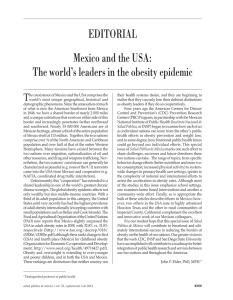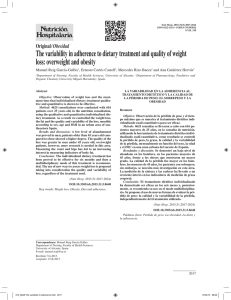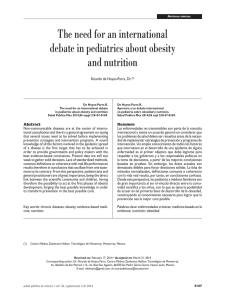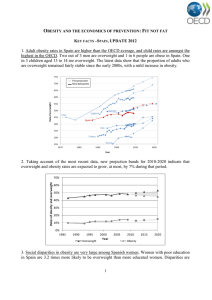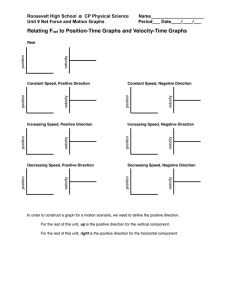High increments of overweight along with low length-for
Anuncio
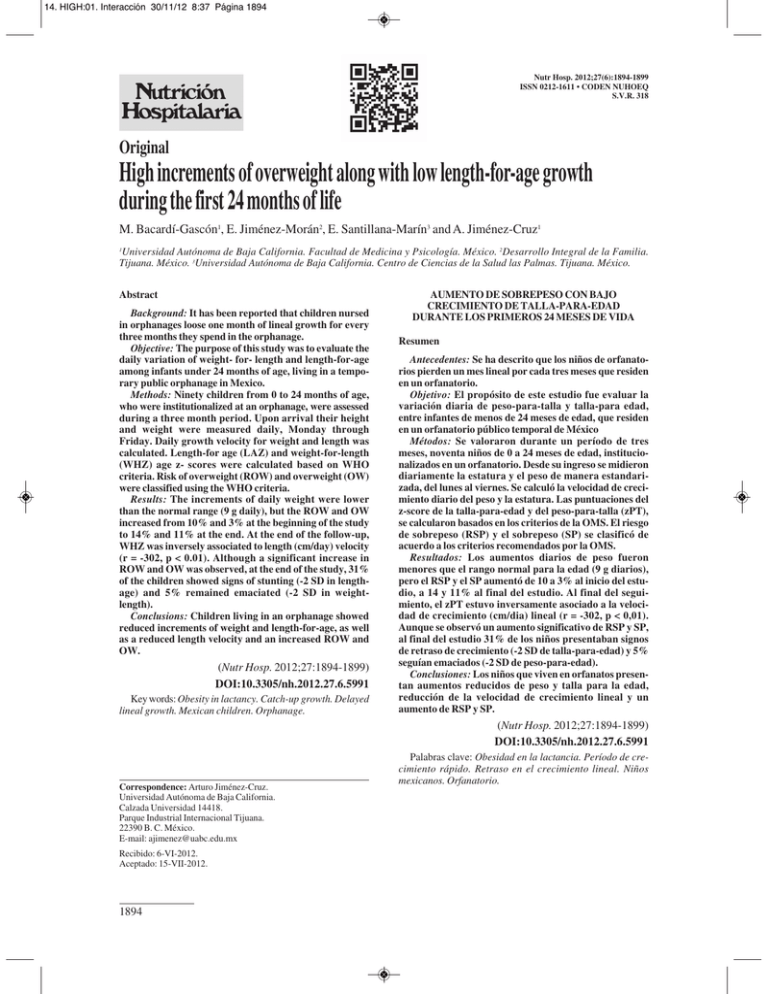
14. HIGH:01. Interacción 30/11/12 8:37 Página 1894 Nutr Hosp. 2012;27(6):1894-1899 ISSN 0212-1611 • CODEN NUHOEQ S.V.R. 318 Original High increments of overweight along with low length-for-age growth during the first 24 months of life M. Bacardí-Gascón1, E. Jiménez-Morán2, E. Santillana-Marín3 and A. Jiménez-Cruz1 1 Universidad Autónoma de Baja California. Facultad de Medicina y Psicología. México. 2Desarrollo Integral de la Familia. Tijuana. México. 3Universidad Autónoma de Baja California. Centro de Ciencias de la Salud las Palmas. Tijuana. México. Abstract Background: It has been reported that children nursed in orphanages loose one month of lineal growth for every three months they spend in the orphanage. Objective: The purpose of this study was to evaluate the daily variation of weight- for- length and length-for-age among infants under 24 months of age, living in a temporary public orphanage in Mexico. Methods: Ninety children from 0 to 24 months of age, who were institutionalized at an orphanage, were assessed during a three month period. Upon arrival their height and weight were measured daily, Monday through Friday. Daily growth velocity for weight and length was calculated. Length-for age (LAZ) and weight-for-length (WHZ) age z- scores were calculated based on WHO criteria. Risk of overweight (ROW) and overweight (OW) were classified using the WHO criteria. Results: The increments of daily weight were lower than the normal range (9 g daily), but the ROW and OW increased from 10% and 3% at the beginning of the study to 14% and 11% at the end. At the end of the follow-up, WHZ was inversely associated to length (cm/day) velocity (r = -302, p < 0.01). Although a significant increase in ROW and OW was observed, at the end of the study, 31% of the children showed signs of stunting (-2 SD in lengthage) and 5% remained emaciated (-2 SD in weightlength). Conclusions: Children living in an orphanage showed reduced increments of weight and length-for-age, as well as a reduced length velocity and an increased ROW and OW. (Nutr Hosp. 2012;27:1894-1899) DOI:10.3305/nh.2012.27.6.5991 Key words: Obesity in lactancy. Catch-up growth. Delayed lineal growth. Mexican children. Orphanage. AUMENTO DE SOBREPESO CON BAJO CRECIMIENTO DE TALLA-PARA-EDAD DURANTE LOS PRIMEROS 24 MESES DE VIDA Resumen Antecedentes: Se ha descrito que los niños de orfanatorios pierden un mes lineal por cada tres meses que residen en un orfanatorio. Objetivo: El propósito de este estudio fue evaluar la variación diaria de peso-para-talla y talla-para edad, entre infantes de menos de 24 meses de edad, que residen en un orfanatorio público temporal de México Métodos: Se valoraron durante un período de tres meses, noventa niños de 0 a 24 meses de edad, institucionalizados en un orfanatorio. Desde su ingreso se midieron diariamente la estatura y el peso de manera estandarizada, del lunes al viernes. Se calculó la velocidad de crecimiento diario del peso y la estatura. Las puntuaciones del z-score de la talla-para-edad y del peso-para-talla (zPT), se calcularon basados en los criterios de la OMS. El riesgo de sobrepeso (RSP) y el sobrepeso (SP) se clasificó de acuerdo a los criterios recomendados por la OMS. Resultados: Los aumentos diarios de peso fueron menores que el rango normal para la edad (9 g diarios), pero el RSP y el SP aumentó de 10 a 3% al inicio del estudio, a 14 y 11% al final del estudio. Al final del seguimiento, el zPT estuvo inversamente asociado a la velocidad de crecimiento (cm/dia) lineal (r = -302, p < 0,01). Aunque se observó un aumento significativo de RSP y SP, al final del estudio 31% de los niños presentaban signos de retraso de crecimiento (-2 SD de talla-para-edad) y 5% seguían emaciados (-2 SD de peso-para-edad). Conclusiones: Los niños que viven en orfanatos presentan aumentos reducidos de peso y talla para la edad, reducción de la velocidad de crecimiento lineal y un aumento de RSP y SP. (Nutr Hosp. 2012;27:1894-1899) DOI:10.3305/nh.2012.27.6.5991 Correspondence: Arturo Jiménez-Cruz. Universidad Autónoma de Baja California. Calzada Universidad 14418. Parque Industrial Internacional Tijuana. 22390 B. C. México. E-mail: ajimenez@uabc.edu.mx Recibido: 6-VI-2012. Aceptado: 15-VII-2012. 1894 Palabras clave: Obesidad en la lactancia. Período de crecimiento rápido. Retraso en el crecimiento lineal. Niños mexicanos. Orfanatorio. 14. HIGH:01. Interacción 30/11/12 8:37 Página 1895 Introduction Pre and postnatal factors have been shown to be associated with obesity and metabolic syndrome later in life.1 Inappropriate nutrition during pregnancy, low and high birth weight, lack of breastfeeding, early weaning, and early adiposity rebound are associated with obesity and these features compound the metabolic syndrome in childhood and later in life.2 There is enough evidence showing that fetal nutrition, as a result of deficient maternal and placenta nutrition, results in growth impairment in children.3,4,5,6,7,8,9,10,11,12 Additionally, for the purpose of enhancing efficiency in catch-up fat, suppressed thermogenesis in certain tissues plays a role in the pathophysiological consequences of catch-up growth.1 Catch-up growth is a fast recovery of weight after periods of deprivation, and catch-up fat is the recovery of weight at the expenses of fat deposition, this phenomenon of preferential fat accumulation has been described as post starvation obesity, and it has been related to abdominal obesity and metabolic syndrome.1,13,14,15 Ong et al.,14 indicated that catch-up growth in infants posed a higher risk of type 2 diabetes, cardiovascular disease, obesity, and metabolic syndrome. Low birth weight has been associated to “catch-up growth” and especially catch-up fat, especially trunk fat, during the first year of life. It has been reported that there is an association between this catch- up growth and catch-up fat with a reduction in insulin sensitivity, HDL cholesterol, and an increase in waist circumference and triglycerides in adult life.1,14,15,16 It has also been observed that a high weight birth is associated to higher body mass index (BMI). Ong14 indicated that catch-up fat might be partially explained by the need of those with intrauterine deprivation for catching-up the weight to standard levels, which is usually done by catching-up fat in the trunk area. A high percentage of children in orphanages might have undergone intrauterine deprivation, thus, these children are at high risk of becoming obese, having abdominal obesity and its later consequences. Anemia and low levels of hemoglobin during pregnancy might be prolonged after birth and during the first months of life.17 In Mexico it has been reported that more than half of women suffer of anemia and iron deficiency, these problems are higher among more vulnerable women groups, such as those in indigenous and rural populations and living under the poverty level of income.18,19 Iron deficiency in children might also play an important role in length impairment. Growth deficit is a problem affecting wide sectors of the infant population in Mexico and Latin America, especially those living in poverty.20,21,22 In the EuroGrowth Study it was found that there is a positive correlation between weight and age when height is increased. It was suggested that age has a mediated effect on weight during early life as a result of intrauterine factors, mainly nutrition factors.23 Thus, Increments of overweight and low lenght-for-age during infancy prenatal factors contribute to early life fetal programming which subsequently leads to a higher susceptibility for both higher rates and earlier onset of certain diseases later in life.24 The last trimester of pregnancy is an essential period for fat mass programming, independently of the postnatal pattern of growth.25 Several studies have reported negative effects on growth as a result of living in an orphanage, poverty, undernutrition, and emotional and psychosocial deprivation.26,27,28,29,30 However, we have found no studies showing whether lineal growth delay is associated with the incidence of obesity in infants, nor the effect of living in an orphanage environment on the incidence of obesity. The purpose of this study is to assess the daily weight and length increments of infants living in an orphanage in Mexico, and to evaluate whether there is an association between growth velocity and overweight. Methods Population The state of Baja California shares a strong economic and cultural relationship with the United States due to its geographical location. In 2006, it had approximately 3,155 070 residents, of which, Tijuana, Baja California had approximately 1,559 683 residents.31 Children at orphanages are mainly “mestizos” (half-blood). The orphanage can accommodate 250 to 300 children (60% boys). Ninety of these children (57% boys) participated in the study. Study design The study was conducted from June 15th to December 15 of 2009, in Tijuana, Mexico. This is a longitudinal study of infants 0-24 months old, living in a public orphanage, with a follow up of three months. Since the orphanage is a short term facility, children residing in the orphanage are usually relocated to a long term orphanage or are given back to their parents upon request and approval. Children with diseases other than obesity or under nutrition, which might affect growth development, were excluded from the study. More than half (56%) of the children were measured the same day they were admitted to the orphanage. Ninety children ranging from 0 to 24 months of age, who were temporarily institutionalized, were measured during 16 weeks on their weight and height. The average age was 8.5 months (3 days to 20 months) and 57% were boys. The range of stay in the orphanage for the rest of the children varied from 5 to 60 days. th Ethics Approval The project was approved by the ethics committee of the nutrition academic body at Universidad Autonoma Nutr Hosp. 2012;27(6):1894-1899 1895 14. HIGH:01. Interacción 30/11/12 8:37 Página 1896 de Baja California. The authorities of the orphanage authorized the study and followed the protocol to accept a research project on the children, and the physician and nutritionist in charge participated in the study. Measurements Age was calculated from the date of birth and the date of the first measurement. Children were measured at the same time each day before feeding, using a measuring mat SECA (model 210, Hamburg, Germany) or a portable stadiometer SECA (model 410, Hamburg, Germany), with precision of 1 mm. Upon arrival, and Monday through Friday, daily length/height and weight were measured until the end of the period. Children were weighed, without diapers and clothes, using a pediatric scale (Health o Meter, Kilo-Pound Beam, Model 1524 KL HON 1901). Weight was measured daily and the scale was also calibrated daily. WHZ was calculated based on WHO criteria. WHZ were compared by age and gender of each child with the corresponding tables of the WHO-2006.26 The scores and percentiles of each child were calculated with SPSS v16, using the parameters provided by the WHO (2006). Weight and length velocity were calculated considering the difference in weight and height change each day. Indices Weight-for-length/height (WHZ) z-scores and length/ height-for-age (HAZ) z-scores were calculated according to age and gender using the WHO (2006) criteria. Weekly variation of height-for-age and weightfor-height was computed during the six month period. WHZ classification was used according to WHO: severely emaciated (≤ -3 SD), emaciated (-2.99 SD to ≤ -2 SD), normal weight (-1.99 SD to ≤ 1 SD), possible risk of OW (> 1 SD to ≤ 2 DE), OW (> 2 SD to ≤ 3 SD), and obesity (> 3 SD). HAZ classification was used according to WHO: Severely stunting (≤ -3 SD), stunting (-2.99 SD to ≤ -2 SD), normal height (-1.99 SD to ≤ 3 SD), and tall (> 3 DE). Statistical Analysis All variables were examined to see if a normal distribution was followed, using the Kolmogorov-Smirnov test. Mann Whitney Ranks non parametric test and student’s t-test for independent samples were used to assess differences in z scores and growth velocity, and the days of living in the orphanage. Growth velocity differences by age group were analyzed using one way ANOVA. Spearman’s correlation was conducted to analyze the association between growth velocity, weight and length increments and weight and weight for length status. 1896 Nutr Hosp. 2012;27(6):1894-1899 Results The prevalence of severely stunted at the beginning of the study was 6.5%, stunted 8.5%, normal length 80%, and tall 5%. During the first three months at the orphanage a weekly decrease in length - for- age zscores was observed in all age groups, but more significantly in younger than three months of age (fig. 1). At the end of the study the prevalence of severe stunting was 20%, stunted 11%, normal length 67%, and tall 2%. On the other hand, at the beginning of the study the prevalence of severe emaciation was 5.6%, emaciated was 6.5%, normal weight was 75.5%, possible ROW was 10%, and OW was 3%. During the first three months in the orphanage, different slopes of weight -for-length zscores were observed, but children younger than three months had a steady increase in weight for length (fig. 2). At the end of the study the prevalence of severe emaciation was 1.5%, emaciated was 3.5%, normal weight was 71%, possible ROW was 14% and OW was 11%. A difference in z- scores and growth velocity in both genders was observed, and this was further seen among children who had lived one or more weeks at the orphanage. By the end of the study 31% of the children remained behind (< -2 DE) in length-for-age and 5% remained emaciated (< -2 DE in weight-for-length). There were no differences in growth velocity between genders. Children that had more than a week in the orphanage presented a lower growth velocity than the newly arrived [0.008± 0.003 and 0.013 ± 0.004 cm/day (p = 0.0001)]. This might be due to age differences or to long term effect of emotional deprivation. The average age of newcomers was 7 ± 6 months, while those with more than a week of stay were 10 ± 5 months (p = 0.005). On average the 0-3 months group had the highest increment in g/d (p = 0.0001) and the 3-6 months group had the highest cm/d (p = 0.02) increment. Table I shows weight and length daily growth. There were no differences in weight increments between the new comers and those that were already at the orphanage. Initial z- scores of length-for-age were greater than the final z- scores in all age groups. Also, it was observed that children with normal zscore of weight-for-length increased their weight from 40 to 60 g/week; children with more than 1SD from 10 to 90 g/week, and children with -2SD from 40 to 90 g/week. Those children who at the beginning of the study had z-scores of length-for-age at -2 SD presented greater increments in length. Weekly increments of weight- for- length z-scores varies depending on the initial weight status, but most emaciated children (< -2SD) had higher increments on weight-for- length z-scores, while normal and those with > 1SD weight-for-length z-scores children had lower weight increments (fig. 3). At the end of the follow-up, the increment of weight was inversely associated to z-scores in length-for-age (r = -0.398, p < 0.01), BMI was also inversely associated to length (cm/day) velocity (r = -0.302, p < 0.01). M. Bacardí-Gascón et al. 14. HIGH:01. Interacción 30/11/12 8:37 Página 1897 2 1 0 z-score <3m -1 3-6 m 6-9 m -2 9-12 m -3 12-20 m -4 Fig. 1.—Weekly mean heightfor-age z-scores by age groups. -5 weeks 1.5 1 <3m z-score 0.5 3-6 m 0 6-9 m -0.5 9-12 m 12-20 m -1 Fig. 2.—Weekly mean weightfor-height z-scores by group age. -1.5 weeks Table I Weight and length daily growth Months 0-3 3-6 6-9 9-12 12-20 Weight g/day Length cm/day 8.5 ± 3.4 7.1 ± 3.0 7.0 ± 3.5 7.1 ± 2.7 4.6 ± 2.1 0.013 ± 0.003 0.013 ± 0.005 0.013 ± 0.004 0.010 ± 0.003 0.009 ± 0.004 Weekly weight increments were higher in children with < -2SD of length-for-age z-score (fig. 4). Discussion At the end of three month follow-up of BMI, infants living in an orphanage were inversely associated to length (cm/day) velocity. A paradoxical trend of weight and length increments was observed. Infants having lower than the average weight increments for their age (9 g/day) had a 12 percentage points (pp) increase in prevalence of ROW and OW. At the same Increments of overweight and low lenght-for-age during infancy time, the prevalence of severe stunting and stunting also increased 16 pp. The high prevalence of ROW and OW observed at the end of the follow-up is consistent with the high prevalence reported among 6 to 24 months old, low-income children from three different cities in Mexico.32 These results might indicate that even with a slight catch-up growth and catch-up fat, infants are prone towards ROW an OW, which may be at the expense of the reduced length velocity or an increase of metabolic efficiency toward fat deposition. Dulloo1 indicates that an increase in metabolic efficiency directed at fat deposition is a fundamental physiological process operating to accelerate fat recovery after growth retardation or weight loss. Through the catch-up fat, continues Dulloo, “a normal physiological process is expressed and characterized by an elevation in the efficiency of cellular energy utilization”. Therefore, rather than a catch-up growth that would include growth velocity and a weight increase, catchup fat seems to prevail even with small increments of weight, which results in ROW and OW. As Dulloo1 states, “the process of catch-up growth per se is a state characterized by a proportionately greater rate of fat deposition relative to lean tissue deposition”. This may occur even with as little increments of weight as 9 Nutr Hosp. 2012;27(6):1894-1899 1897 14. HIGH:01. Interacción 30/11/12 8:37 Página 1898 100 90 80 70 2SD 60 normal 50 > 1SD 40 30 p = 0.05 p = 0.0001 20 10 0 Fig. 3.—Mean weekly weight increments by baseline weight-for-length z-score. weeks 100 90 80 70 g 60 50 < -2SD 40 normal 30 20 10 p = 0.0006 0 weeks g/day in the first two months of age, as it occurred in these children. This state of preferential catch-up fat, says Dulloo,1 “is brought about, at least in part, via the suppression of thermogenesis, which precedes the appearance of excess body fat and central fat distribution, and is a central event that predisposes individuals with catch-up fat to abdominal obesity, type 2 diabetes and cardiovascular disease”.1 Some maternal diseases might affect the weight and height of children.33,34,35 Unfortunately, we did not have maternal health history, but no children were HIV positive. Most children living in an orphanage come from an adverse pre and postnatal environment, including lack of pre natal control, maternal alcoholism, smoking or taking other drugs during pregnancy and inappropriate delivery settings when the child is born.36,37 The inverse association of the length velocity with the increase of obesity observed in this study might indicate that an objective to prevent childhood obesity should be focused to prevent the reduced length velocity in infants, as well as appropriate pre-natal care. 1898 Nutr Hosp. 2012;27(6):1894-1899 Fig. 4.—Mean weekly weight increments by baseline height-for-age z-score. The strengths of this study include that it was conducted in a homogeneous environment, the same physician and personnel helped throughout the study, and the children’s care was not interrupted. However, the limitations rest on the lack of records of maternal health prior, during, and after the birth and the birth weight of the children. All those data might indicate the neglecting care before the arrival of the child to the orphanage. Several studies have reported negative effects on growth as a result of living in an orphanage, poverty, undernutrition, emotional and psychosocial deprivation.24,25,26,27,28 Inappropriate nutrition during pregnancy, low and high birth weight, lack of breastfeeding, and early weaning, not reported in most of these children, might also be associated with the high increments of obesity.2 Children living in an orphanage showed a process of reduced increments of weight and length for their age, as well as a reduced length velocity along with increase ROW and OW. These results suggest the urgent need of including a nutritionally aggressive care plan for children M. Bacardí-Gascón et al. 14. HIGH:01. Interacción 30/11/12 8:37 Página 1899 growing up in adverse environments in order to treat undernutrition and prevent obesity. Additionally, the process should be further studied to find out how this might have an effect on long term consequences of abdominal obesity, to see if this physiologic process is leading to higher levels of obesity among low income populations, and to find out which might be the appropriate nutrient composition to prevent early abdominal fat deposition and length delay in children living in poverty, and in economical or emotional deprivation. 17. 18. 19. 20. References 1. Dulloo AG. Regulation of Fat Storage via Suppressed Thermogenesis: A Thrifty Phenotype That Predisposes Individuals with Catch-Up Growth to Insulin Resistance and Obesity. Horm Res 2006; 65 (Suppl. 3): 90-97. 2. Gökçay G, Turan JM, Partalci A, Neyzi O. Growth of infants during the first year of life according to feeding regimen in the first 4 months. J Trop Pediatr 2003; 49 (1): 6-12. 3. Godfrey K, Robinson S, Barker DJ, Osmond C, Cox V. Maternal nutrition in early and late pregnancy in relation to placental and fetal growth. BMJ 1996; 312 (7028): 410-14. 4. Biosca M, Rodríguez G, Ventura P, Samper MP, Labayen I, Collado MP, Valle S, Bueno O, Santabarbara J, Moreno LA. Central adiposity in children born small and large for gestational age. Nutr Hosp 2011; (26) 4: 971-976. 5. Mathews SF, Yudkin P, Neil A. Influence of maternal nutrition on outcome of pregnancy: prospective cohort study. British Medical Journal 1999; 319: 339-343. 6. Mathews SF, Youngman L, Neil A. Maternal circulating nutrient concentrations in pregnancy: implications for birth and placental weights of term infants. American Journal of Clinical Nutrition 2004; 79: 103-110. 7. Bavdekar A, Yajnik CS, Fall CH, Bapat S, Pandit AN, Deshpande V, Bhave S, Kelligray SD, Joglekar C. Insulin resistant syndrome in 8 year old Indian children: small at birth, big at 8 year, or both? Diabetes 1999; 48 (12): 2422-9. 8. Ong KK, Ahmed ML, Emmett PM, Preece MA, Dunger DB. Association between post-natal catch up growth and obesity in childhood: prospective cohort study. BMJ 2000; 320 (7240): 967-71. 9. Crowther NJ, Trusler J, Cameron N, Toman M, Gray IP. Relation between weight gain and beta-cell secretory activity and non-esterified fatty acid production in 7 year-old African children: results from the Birth to Ten study. Diabetología 2000; 43: 978-985. 10. Barker DJP, Eriksoon JG, Forsen T, Osmond C. Fetal origins of adult disease: strength of effects and biological basis. International Journal of Epidemiology 2002; 31: 1235-1239. 11. Adair LS, Cole TJ. Rapid child growth raises blood pressure in adolescent boys who were thin at birth. Hypertension 2002; 41: 451-456. 12. Wells JC, Chomtho S, Fewtrell MS. Programming of body composition by early growth and nutrition. Proceedings of the Nutrition Society 2007; 66 (3): 423-434. 13. Dulloo AG, Jacquet J, Montani JP: Pathways from weight fluctuations to metabolic diseases: focus on maladaptive thermogenesis during catch-up fat. Int J Obes Relat Metab Disord 2002; 26 (Suppl. 2): S46-S57. 14. Ong KK. Size at Birth, Postnatal Growth and Risk of Obesity. Horm Res 2006; 65 (Suppl. 3): 65-69. 15. Ezzhair N, Alberti C, Deghmoun S, Zaccaria I, Czernichow P, Lévy-Marchal C, Jaquet D. Time course of catch up in adiposity influences adult anthropometry in individuals who were born small for gestational age. Pediatr Res 2005; 58 (2): 243-7. 16. Ibáñez L, Ong K, Dunger DB, Dezegher F. Early development of adiposity and insulin resistance after catch up weight gain in Increments of overweight and low lenght-for-age during infancy 21. 22. 23. 24. 25. 26. 27. 28. 29. 30. 31. 32. 33. 34. 35. 36. 37. small–for-gestational-age children. J Clin Endocrinol Metab 2006; 91 (6): 2153-8. Telatar B, Comert S, Vitrinel A, Erginoz E, Akin Y. V The effect of maternal anemia on anthropometric measurements of newborns. Saudi Med J 2009; 30 (3): 409-12. Casanueva E, De Regil LM, Flores-Campuzano MA. Anemia por deficiencia de hierro en mujeres mexicanas en edad reproductiva. Historia de un problema no resuelto. Salud Pública Méx 2006; vol.48 no.2 Cuernavaca Mar./Apr. Shamah-Levy T, Villalpando S, Rivera JA, Mejía-Rodríguez F, Camacho-Cisneros M, Monterrubio EA. Anemia in Mexican women: A public health problem. Salud Pública Méx 2003; 45 (Suppl. 4): 499-507. Rivera JA, Sotres-Alvarez D, Habicht JP, Shamah T, Villalpando S. Impact of the Mexican program for education, health, and nutrition (Progresa) on rates of growth and anemia in infants and young children: a randomized effectiveness study. JAMA 2004; 291 (21): 2563-70. Duran P, Caballero B, de Onis M.The association between stunting and overweight in Latin American and Caribbean preschool children. Food Nutr Bull 2006; 27 (4): 300-5. Atela Urquijo P, Martín Ibáñez I Sainz de la Maza T. Evaluación de la intervención terapéutica realizada en un centro de recuperación nutricional infantil de Nicaragua. Nutr Hosp 2011; 26 (6): 1345-1349. Van’T Hof MA, Haschke F, the Euro-Growth Study Group. The Euro-Growth Study: Why, Who and How. J Pediatr Gastroenterol Nutr 2000; 31 (Suppl. 1): S3-S13. Lucas A, Davies PS, Day JM. Energy expenditure in early infancy and later body fatness. Int J Obes 1991; 15 (11): 72731. Uthaya S, Thomas EL, Hamilton G, Doré CJ, Bell J, Modi N. Altered adiposity after extremely preterm birth. Pediatr Res 2005; 57 (2): 211-5. Otieno PA, Nduati RW, Musoke RN, Wasunna AO. Growth and Development of Abandoned Babies in Institutional Care in Nairobi. East African Medical Journal 1999; 76 (8): 430-5. Miller LC et al. Development and Nutritional Status of Internationally adopted Children. Arch Pediatr Adolesc Med 1995; 149: 40-45. Voos LD, Mulligan J, Betts PR. Short Stature at School Entry. An index of social Deprivation? Child Care Health and Development 1998; 24 (2): 145-56. Martin HP, Beezley P. Beehavioural observations of abused children. Dev Med Child Neurol 1977; 19: 373-87. Hensey OPJ, Williams JK, Rosenblom L. Intervention in child abuse-experience in Liverpool. Dev Med Child Neurol 1983; 25: 606-11. INEGI. Censo General de la Población y Vivienda (2010). INEGI, San Luis Potosi, Mexico, 2010. http://www.inegi.org. mx/default.aspx. (Accessed 03/10/2012). Jiménez Cruz A, Bacardí Gascón M, Pichardo Osuna A, Mandujano-Trujillo Z, Castillo-Ruiz O: Infant and Toddlers’ Feeding Practices and Obesity amongst Low-income Families in Mexico. Asia Pac J Clin Nutr 2010; 19 (3): 316-23. Rodríguez S, Ferris AM, Perez-Escamilla R, Backstrand JR. Obesity among offspring of women with type I diabetes. Clinical and Investigative Medicine 1998; 21: 258-266. Whitaker RC, Pepp MS, Seidel KD, Wriger JA, Knopp Rh. Gestational diabetes and the risk of offspring obesity. Pediatrics 1998; 101: 2 e9. Dabalea D, Pettitt DJ. Intrauterine diabetic environment confers risks for type 2 diabetes mellitus and obesity in the offspring, in addition to genetic susceptibility. J Pediatric Endocrinol Metab 2001; 14 (8): 1085-1. Covington CY, Nordstrom-Klee B, Ager J, Sokol R, DelaneyBlack V. Birth to age 7 growth of children prenatally exposed to drugs: a prospective cohort study. Neurotoxicol Teratol 2002; 24 (4): 489-96. Brown KH, Sánchez-Grinan L, Pérez F, Peerson JM. Effects of dietary energy and feeding frecuency on total daily intakes of recovering malnourished children. Am J Clin Nutr 1995; 62: 13-18. Nutr Hosp. 2012;27(6):1894-1899 1899
